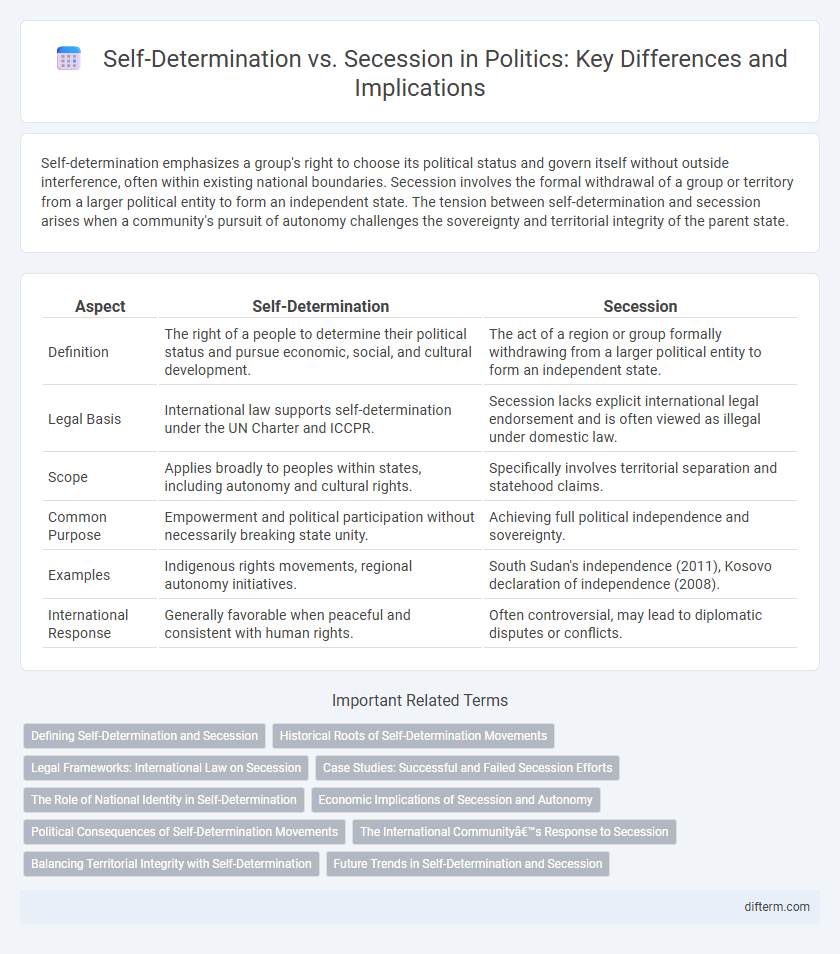Self-determination emphasizes a group's right to choose its political status and govern itself without outside interference, often within existing national boundaries. Secession involves the formal withdrawal of a group or territory from a larger political entity to form an independent state. The tension between self-determination and secession arises when a community's pursuit of autonomy challenges the sovereignty and territorial integrity of the parent state.
Table of Comparison
| Aspect | Self-Determination | Secession |
|---|---|---|
| Definition | The right of a people to determine their political status and pursue economic, social, and cultural development. | The act of a region or group formally withdrawing from a larger political entity to form an independent state. |
| Legal Basis | International law supports self-determination under the UN Charter and ICCPR. | Secession lacks explicit international legal endorsement and is often viewed as illegal under domestic law. |
| Scope | Applies broadly to peoples within states, including autonomy and cultural rights. | Specifically involves territorial separation and statehood claims. |
| Common Purpose | Empowerment and political participation without necessarily breaking state unity. | Achieving full political independence and sovereignty. |
| Examples | Indigenous rights movements, regional autonomy initiatives. | South Sudan's independence (2011), Kosovo declaration of independence (2008). |
| International Response | Generally favorable when peaceful and consistent with human rights. | Often controversial, may lead to diplomatic disputes or conflicts. |
Defining Self-Determination and Secession
Self-determination refers to the right of peoples and nations to freely choose their political status and pursue economic, social, and cultural development. Secession is the act of a region or group formally breaking away from an existing state to form an independent sovereign entity. While self-determination emphasizes autonomy and political participation within or outside a state, secession entails a formal and often legally contentious separation process.
Historical Roots of Self-Determination Movements
Self-determination movements trace their origins to the 19th century nationalist struggles and the principle was further solidified by Woodrow Wilson's Fourteen Points during World War I. These movements often emerged in colonies and multi-ethnic empires where distinct ethnic groups sought political autonomy or independence based on shared language, culture, and history. The post-World War II decolonization era saw a surge in self-determination claims, challenging imperial borders and fostering the creation of new nation-states.
Legal Frameworks: International Law on Secession
International law on secession primarily revolves around principles of territorial integrity and the right to self-determination, often creating complex legal tensions. The United Nations Charter emphasizes state sovereignty and prohibits unilateral secession unless supported by a legitimate decolonization process or severe oppression. Key legal precedents, such as the International Court of Justice's advisory opinions, recognize secession mainly in situations of failed state protection or systemic human rights violations.
Case Studies: Successful and Failed Secession Efforts
The distinction between self-determination and secession is critical in understanding political sovereignty, with case studies such as South Sudan's successful secession in 2011 exemplifying international acceptance of self-determination leading to statehood. Conversely, the Catalonia independence referendum in 2017 highlights a failed secession effort due to legal opposition and lack of recognition from the Spanish government and international bodies. These cases illustrate how international law, political legitimacy, and diplomatic recognition determine the success or failure of secession movements.
The Role of National Identity in Self-Determination
National identity serves as a foundational element in self-determination by fostering a shared sense of heritage, culture, and values among a distinct group, legitimizing their political aspirations. The strength of national identity often influences the degree to which populations pursue self-determination as a means to achieve autonomy without necessarily seeking full secession. Political movements that emphasize national identity leverage this collective consciousness to mobilize support for self-governance within existing state frameworks, balancing unity and regional distinctiveness.
Economic Implications of Secession and Autonomy
Secession often leads to significant economic challenges including trade disruptions, loss of shared fiscal resources, and increased administrative costs, while autonomy allows regions to tailor fiscal policies without severing economic ties. Autonomous regions can attract investment through localized economic reforms and retain a degree of economic integration with the parent state, mitigating risks of market fragmentation. Conversely, outright secession may trigger capital flight, trade barriers, and uncertainty, impacting GDP growth and public service funding.
Political Consequences of Self-Determination Movements
Self-determination movements often challenge existing national boundaries, leading to political instability and conflicts over sovereignty in affected regions. These movements can provoke governmental repression or reforms, influencing domestic and international political dynamics. The pursuit of self-determination may result in increased regional autonomy or full secession, reshaping geopolitical landscapes and diplomatic relations.
The International Community’s Response to Secession
The international community generally upholds the principle of self-determination within existing state borders, emphasizing respect for sovereignty and territorial integrity. Secessionist movements often face limited recognition unless they achieve broad diplomatic and legal acceptance, as seen in cases like Kosovo. International bodies such as the United Nations typically advocate for negotiated solutions over unilateral declarations of independence to maintain global stability.
Balancing Territorial Integrity with Self-Determination
Balancing territorial integrity with self-determination involves respecting a state's sovereignty while acknowledging the rights of distinct groups to pursue autonomy. International law emphasizes preserving existing borders to maintain global stability, yet recognizes self-determination as a principle under the United Nations Charter. Key case studies like Kosovo and Catalonia illustrate the challenges of reconciling these competing interests without undermining peace and order.
Future Trends in Self-Determination and Secession
Future trends in self-determination and secession are increasingly influenced by digital globalization and shifting geopolitical alliances, which empower regions to assert autonomy while complicating state sovereignty. Emerging international legal frameworks may balance the right to self-determination with the need for territorial integrity, shaping diplomatic responses to secessionist movements. Advances in communication technology enable decentralized political mobilization, making secessionist claims more visible and internationally supported.
self-determination vs secession Infographic

 difterm.com
difterm.com